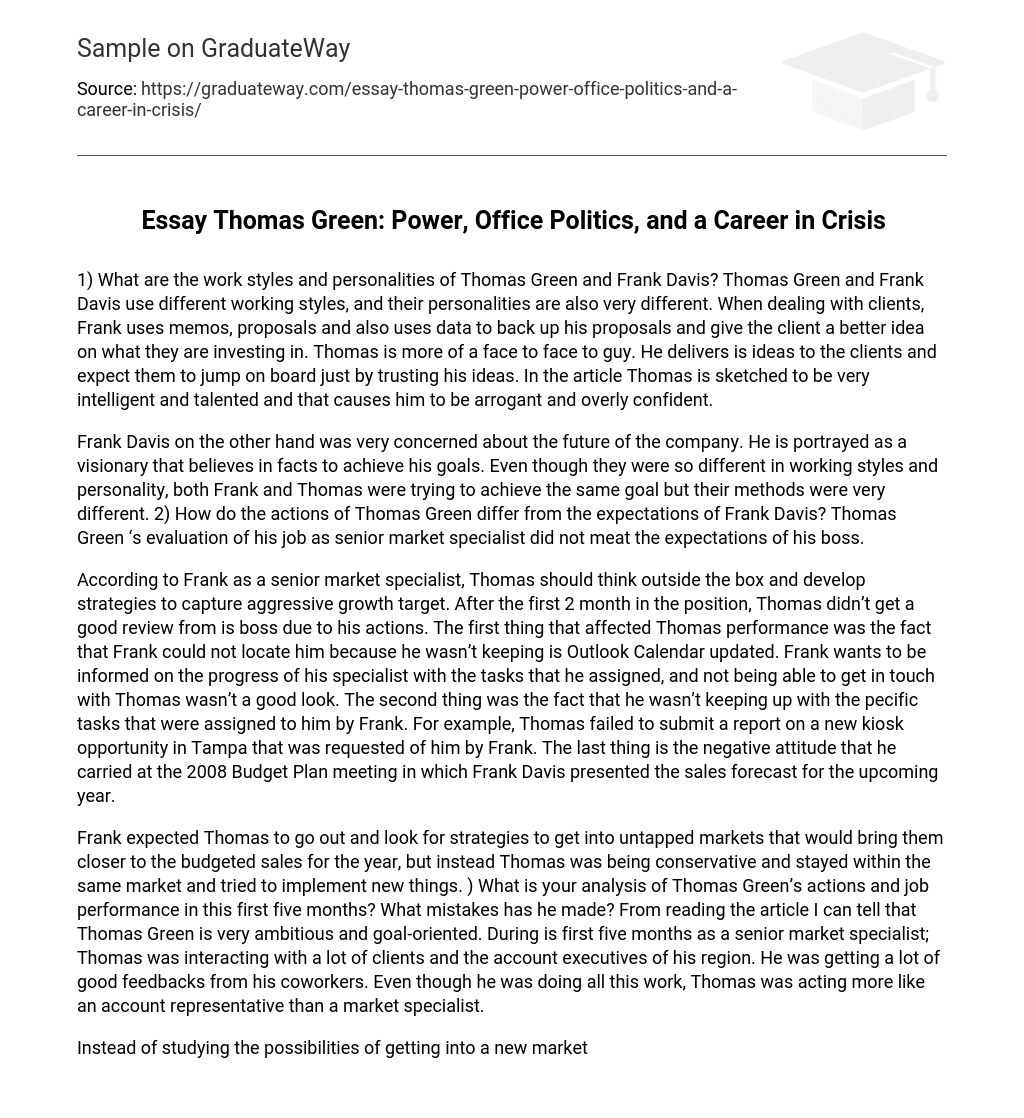The work styles and personalities of Thomas Green and Frank Davis differ significantly. Frank uses memos, proposals, and data to support his proposals when dealing with clients. On the other hand, Thomas prefers face-to-face communication, expecting clients to trust his ideas. The article portrays Thomas as highly intelligent and talented, which makes him arrogant and excessively confident.
Frank Davis and Thomas Green had different approaches and concerns regarding the future of the company. While Davis was a visionary who believed in using facts to achieve his goals, Green had a different working style and personality. Despite their differences, both Davis and Green shared the same goal but had contrasting methods. However, Green’s actions as a senior market specialist did not meet the expectations of his boss, Frank Davis.
According to Frank, as a senior market specialist, Thomas needs to think creatively and develop strategies to achieve aggressive growth targets. However, after his first two months in the position, Thomas received a negative review from his boss. There were several factors that contributed to Thomas’ poor performance. Firstly, Frank had difficulty finding Thomas because he did not keep his Outlook Calendar updated. Frank wanted to be kept informed about the progress of his specialist and being unable to reach Thomas reflected poorly on him. Secondly, Thomas failed to complete specific tasks assigned to him by Frank. For instance, he did not submit a report on a new kiosk opportunity in Tampa as requested. Lastly, Thomas displayed a negative attitude during the 2008 Budget Plan meeting where Frank presented sales forecasts for the coming year.
Frank was expecting Thomas to explore new strategies to enter untapped markets and meet the sales targets for the year. However, Thomas chose to stay conservative and focused on implementing new ideas within the same market. This approach was not in line with Frank’s expectations. The analysis of Thomas Green’s actions and job performance in the first five months suggests that he is ambitious and goal-oriented. As a senior market specialist, Thomas actively engaged with clients and account executives in his region, receiving positive feedback from colleagues. However, despite these efforts, Thomas seemed to act more like an account representative rather than a market specialist.
Instead of exploring new market opportunities, Thomas decided to sell the same product with a few modifications. This approach caused him to disappoint both the company and his superiors. Thomas disregarded the company’s guidelines and created his own. His failure to adapt his working style after meeting Frank Davis was his biggest mistake. Now, Thomas is concerned about whether he will be able to retain his job at Dynamic Displays.
After analyzing Thomas Green’s behavior following his initial meeting with Frank Davis, it can be determined that he employed an avoidance conflict management style. This can be supported by examples from the case study. For a period of three months after the meeting on October 15, Thomas primarily dedicated his time to working independently on his special project and disregarded all of Davis’ recommendations. Additionally, it is stated that during this duration, Thomas actively avoided any interactions with Davis whenever possible. His strategy of engaging in independent work with his market specialist and clients clearly exemplifies his avoidance of addressing the conflict at hand.
Thomas Green persisted in his disagreement with his boss’s budget and continued to act independently. He specifically mentioned that he intentionally avoided direct communication with Frank Davis, stating, ” I deliberately steer clear of him…”. However, the more Thomas avoided the conflict, the more problematic it became. Following the January 2008 meeting, Thomas discussed his perspective with others such as Ms. McDonald and friends, but never confronted Frank Davis directly regarding their ongoing issues.
If I were Thomas Green, I would consider taking the following actions: addressing the conflict directly with Frank Davis to find a resolution, seeking mediation or advice from a neutral party if necessary, and actively listening to Frank’s feedback and concerns. I would recommend employing a collaborative conflict-management style in order to promote open communication and find a mutually beneficial solution between Thomas and Frank.
If I were Thomas Green, my top priority would be to safeguard my position within the company, particularly to save my job. To achieve this, I would start by sending a memo to both Ms. McDonald and Frank Davis, requesting a meeting to discuss the root cause of the conflict. During the meeting, I would take responsibility and acknowledge the existence of a miscommunication issue between Frank and myself. I would apologize to Ms. McDonald for the trouble I have caused and proceed to present my case to her. Additionally, I would assure her that I will comply with her recommendations. Once I have dealt with McDonald, I would then address the conflict with Frank Davis.
I would acknowledge my mistakes and promise to follow the company’s rules. To handle the conflict, I would utilize the accommodation style, which involves yielding to others’ desires in order to resolve conflicts. By employing this approach, I can retain my job despite having differing opinions from my boss. Once the conflict is resolved, I will exert my utmost effort to meet Davis’ 2008 projections. During the next year’s budget meeting, I will ensure to present the ideas I had regarding the projects I worked on in the previous year.





